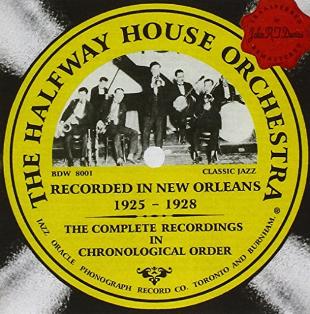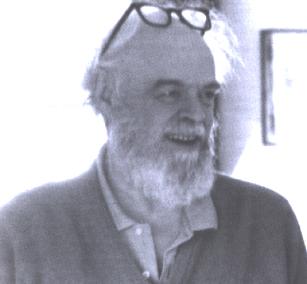
Editor, Webmaster: Phil Cartwright Editor@earlyjas.org
|
| Earlville Association for Ragtime Lovers Yearning for Jazz Advancement and Socialization |
EARLYJAS
The Halfway House Orchestra * 1925-1928 *
Jazz Oracle * BDW 8001*
remastered by John R.T. Davies
Jazz Oracle * BDW 8001*
remastered by John R.T. Davies
Band leader Albert Brunies's mellow and coolly swinging cornet sets the
tone for these recordings, which feature the working band of the Halfway House,
a stop on the road between New Orleans and Lake Pontchartrain in the 1920s.
Like so many others of the era, the Halfway House Orchestra was a dance band
filled with jazz players. From the opening of "Pussy Cat Rag" (co-written by
Brunies plus clarinetist Charlie Cordella, and pianist Mickie Marcour) the band is
balanced and sonorous. The banjo playing of Bill Eastwood (also a co-composer
of "Barataria") and Angelo Palmisano is well recorded for the era--they come
across as the driving center of the rhythm section on most of the tracks. Balance
seems a hallmark of the whole band, both musically and soundwise on these
twenty two tunes recorded by Okeh and Columbia in New Orleans, remastered
by John R.T. Davies in the 1990s.
For clarinetists, this disc is particularly important as a document of the last
recordings of Leon Roppolo, legendary clarinetist of the New Orleans Rhythm
Kings, just before he was committed to the Louisiana State Asylum at the age of
23, and Sidney Arodin, whose playing rounds out the album. Roppolo's
contributions to the recording catalog of the Halfway House were not to be as
extensive or important as those he made with the NORK, as he was only present
for the first two on this disc, both dating from the Okeh session on January 22,
1925, but because it's Rapp playing, they're important nonetheless.
During Cordella's tenure, the band had several significant sessions for
Columbia. On September 25, 1925, they produced crisp, impressive versions of
"Squeeze Me", "Maple Leaf Rag", "Let Me Call You Sweetheart", and an
interesting number by the Bill Whitmore, then the band's pianist, called "New
Orleans Shuffle." Likewise, April 13, 1926 showed the band in good form,
recording "Snookum", "Since You're Gone", "It Belongs to You", and "I'm in
Love", all of which were released commercially.
The October 24, 1927 session features Cordella swinging through solid solos on
"When I'm Blue" and "I Want Somebody to Love" (both written by the band's
pianist, "Red" Long), but the focus of the band remains the mellow cornet of
Brunies.
By 1928, Sidney Arodin (most famous to jazz history as the composer of "Lazy
River") takes over the clarinet chair, and his solos over the last eight cuts show
how good a move that was for the band. Arodin's playing is strong, confident,
and possessed of a sound rare in those days for its solid, mature quality. In fact,
his playing sounds shockingly like Artie Shaw's of a decade later on tunes such as
"Just Pretending" (recorded on December 17, 1928).
While the whole disc is a pleasure to listen to, clarinetists will particularly want
to hear Arodin. While some of the tunes he played were never released by
Columbia, such as "I Hate Myself for Lovin' You" and "Let Your Lips Touch
My Lips", it wasn't the clarinet soloing that held them back, and tunes like "Tell
Me Who" and "Wylie Avenue Blues" give us a glimpse into the playing of a
clarinetist who should be more widely known and appreciated.
tone for these recordings, which feature the working band of the Halfway House,
a stop on the road between New Orleans and Lake Pontchartrain in the 1920s.
Like so many others of the era, the Halfway House Orchestra was a dance band
filled with jazz players. From the opening of "Pussy Cat Rag" (co-written by
Brunies plus clarinetist Charlie Cordella, and pianist Mickie Marcour) the band is
balanced and sonorous. The banjo playing of Bill Eastwood (also a co-composer
of "Barataria") and Angelo Palmisano is well recorded for the era--they come
across as the driving center of the rhythm section on most of the tracks. Balance
seems a hallmark of the whole band, both musically and soundwise on these
twenty two tunes recorded by Okeh and Columbia in New Orleans, remastered
by John R.T. Davies in the 1990s.
For clarinetists, this disc is particularly important as a document of the last
recordings of Leon Roppolo, legendary clarinetist of the New Orleans Rhythm
Kings, just before he was committed to the Louisiana State Asylum at the age of
23, and Sidney Arodin, whose playing rounds out the album. Roppolo's
contributions to the recording catalog of the Halfway House were not to be as
extensive or important as those he made with the NORK, as he was only present
for the first two on this disc, both dating from the Okeh session on January 22,
1925, but because it's Rapp playing, they're important nonetheless.
During Cordella's tenure, the band had several significant sessions for
Columbia. On September 25, 1925, they produced crisp, impressive versions of
"Squeeze Me", "Maple Leaf Rag", "Let Me Call You Sweetheart", and an
interesting number by the Bill Whitmore, then the band's pianist, called "New
Orleans Shuffle." Likewise, April 13, 1926 showed the band in good form,
recording "Snookum", "Since You're Gone", "It Belongs to You", and "I'm in
Love", all of which were released commercially.
The October 24, 1927 session features Cordella swinging through solid solos on
"When I'm Blue" and "I Want Somebody to Love" (both written by the band's
pianist, "Red" Long), but the focus of the band remains the mellow cornet of
Brunies.
By 1928, Sidney Arodin (most famous to jazz history as the composer of "Lazy
River") takes over the clarinet chair, and his solos over the last eight cuts show
how good a move that was for the band. Arodin's playing is strong, confident,
and possessed of a sound rare in those days for its solid, mature quality. In fact,
his playing sounds shockingly like Artie Shaw's of a decade later on tunes such as
"Just Pretending" (recorded on December 17, 1928).
While the whole disc is a pleasure to listen to, clarinetists will particularly want
to hear Arodin. While some of the tunes he played were never released by
Columbia, such as "I Hate Myself for Lovin' You" and "Let Your Lips Touch
My Lips", it wasn't the clarinet soloing that held them back, and tunes like "Tell
Me Who" and "Wylie Avenue Blues" give us a glimpse into the playing of a
clarinetist who should be more widely known and appreciated.

John R. T. Davies: The Master of Mastering Jazz Recordings
Eric Seddon’s review on the opposite page indicates that John R. T. Davies
remastered the music. If you look closely at the lower right corner of the label
you may be able to see the names of two towns: Toronto and Burnham.
Burnham?? Burnham is a village in Buckinghamshire about 9 miles WNW of
London Heathrow airport and is the home of the subject of this piece: John R.
T. Davies.
John (also colloquially “Ristic”) is not well known in the United States but he is
revered by British musicians and jazz record collectors worldwide. In addition to
playing many instruments in many jazz bands, he is an expert in preparing (or
mastering) jazz recordings for production by record companies.
In 1975, whilst I was living and playing jazz in London, I had the delightful
experience of watching the master at work in his barn studio at Walnut Tree
Cottage, Burnham, Bucks. For several months, I traveled from London to spend
Wednesday afternoons with him. I observed his mastering process -- pre-digital,
1/2” tapes, scissors, tape and razor blades! Also, I “helped” him do aural
verifications of musicians listed in an upcoming edition of Brian Rust’s two
volume Jazz Records: 1897-1942. Quite an experience for me! (Phil
Cartwright, Editor)
Eric Seddon’s review on the opposite page indicates that John R. T. Davies
remastered the music. If you look closely at the lower right corner of the label
you may be able to see the names of two towns: Toronto and Burnham.
Burnham?? Burnham is a village in Buckinghamshire about 9 miles WNW of
London Heathrow airport and is the home of the subject of this piece: John R.
T. Davies.
John (also colloquially “Ristic”) is not well known in the United States but he is
revered by British musicians and jazz record collectors worldwide. In addition to
playing many instruments in many jazz bands, he is an expert in preparing (or
mastering) jazz recordings for production by record companies.
In 1975, whilst I was living and playing jazz in London, I had the delightful
experience of watching the master at work in his barn studio at Walnut Tree
Cottage, Burnham, Bucks. For several months, I traveled from London to spend
Wednesday afternoons with him. I observed his mastering process -- pre-digital,
1/2” tapes, scissors, tape and razor blades! Also, I “helped” him do aural
verifications of musicians listed in an upcoming edition of Brian Rust’s two
volume Jazz Records: 1897-1942. Quite an experience for me! (Phil
Cartwright, Editor)
